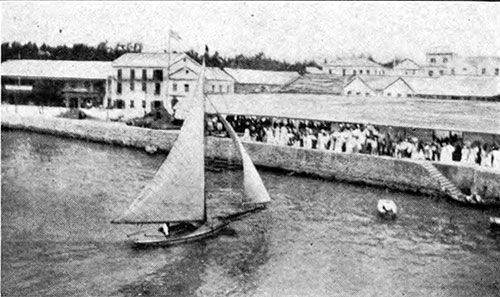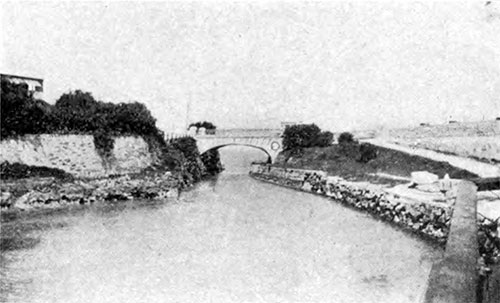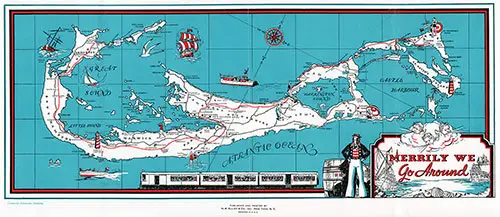Ports of Bermuda Islands
Map of the Bermuda Islands circa Late 1930s. Published and Printed by H. R.. Elliot & Co., Inc. New York. Printed in the USA. GGA Image ID # 1316e7bda4
The Bermudas, or Bermuda as this group is known today, is the world's most northerly group of coral islands, situated in a southeasterly direction, 666 miles from New York, 568 miles from Cape Hatteras, and 720 miles from Halifax.
BERMUDA - 1907

The Landing at Hamilton in the Bermuda Islands. By Rail or Water, 1907. GGA Image ID # 14c3548c04
Forty-five hours from New York the Bermuda Islands form an ideal resort for American travelers who seek an entire change of scene in a brief space of time. Protected by the Gulf Stream this land of the lily and the rose knows neither the cold of winter nor the heat of summer. The temperature is rarely below sixty degrees, and rarely above eighty.
For two centuries the islands have been cared for by England and millions of pounds have been spent in cutting roads and building the island forts. In the coral formation of the group nature has provided drainage to every spot, in making the islands famous as a health resort.
The beauty of Bermuda attracted Tom Moore and the house in which he lived at Walsingham is of interest to visitors as what is reputed to be the oldest private residence in the Bermudas. In raptures over the beauty of the tropics the Irish poet wrote:

The Bridge at Ireland Island in Bermuda. By Rail or Water, 1907. GGA Image ID # 14c37b2b59
Could you but view the scenery fair
That now beneath my window lies,
You'd think that Nature lavished there
Her purest wave. her softest skies.
But. bless the little 'fairy isle:
How sweetly. after all our ills.
We saw the sunny morning smile
Serenely o'er its fragrant hills.
The Islands are within two days' sail of New York, by the fast and commodious steamships of the Quebec Steamship Company, Ltd. Their latitude is about 32° 16' North, and longitude about 64 ° 50' West, and that they lie 600 miles east by south from Cape Hatteras.
The group is some 25 miles in length; and it consists of four principal islands, connected by bridges, and a large number of smaller islets. The area is about 19 1/2 square miles.
When the traveler leaves New York he bids farewell to ice and snow. The next day it begins to grow warmer and wraps and coats are laid aside. When the Gulf Stream is passed both sky and sea take on deeper and brighter hues, and the flying fish may be seen between the waves.
Emerald green and sparkling white the islands at last come in view in this placid sea. The colored pilot comes aboard, and the ship finds her way through the coral reef.
Towards this barrier the Ship speeds along the coast which forms an ever changing, ever interesting panorama. At last Hamilton, the capital, is reached with its fine hotels and hospitable people.
Come and see me about a trip to Bermuda. It will interest you.
The Bermuda Islands - 1938
The Bermudas, or Bermuda as this group is known today, is the world's most northerly group of coral islands, situated in a southeasterly direction, 666 miles from New York, 568 miles from Cape Hatteras, and 720 miles from Halifax.
Bermuda -- The All Year Mid-Ocean Playground
Hundreds of miles from the nearest land, yet only 40 hours from New York on the speedy, luxurious "Monarch of Bermuda" and "Queen of Bermuda" lies the picturesque group of some 365 islands which the world knows as Bermuda.
They are the most northerly coral islands in the world, and this perhaps is responsible for the remarkable climate they enjoy: warm in Winter, cool and breezy in Summer, and ideally adapted to sports and outdoor recreation in all seasons.
No wonder Bermuda has become so popular with vacationists young and old!
And no wonder the Furness trip has become such a favorite!
Built especially for the Bermuda run, "pleasure-planned" for the merriment and gayety of the two-day voyage, and providing the ultimate ocean luxury —a private bath with every room— these ships are the finest ever placed
in regular service on any short ocean run!
We hope you will enjoy your voyage to the utmost—and remember the Furness "pleasure-plan," (the night-club cafes, swimming pool, cocktail bars, sports facilities, $250,000 dance deck, ship-to-shore phones, and other features) as the most delightful shipboard layout you have ever known.
One of your most striking impressions of Bermuda, if this is your first trip, will be the atmosphere of repose and peace that one enjoys in the little ocean domain from which automobiles are rigorously excluded.
Visitors and residents alike go about in stately old-fashioned victorias—or on bicycles! For long trips, the Bermuda Railway has now made it possible to travel the length of the islands, from St. George's to Hamilton and Somerset, in speedy gasoline trains.
But this is the only visible compromise with modernity, and travelers from the land of elevated trains, subways, noisy street-cars, and traffic snarls are deeply grateful — especially when they discover that wireless telephone communication with Europe and America is available at any time, just as it is on shipboard.
Bermuda has more than her share of natural wonders, too—the Magic Crystal Cave—the Sea Gardens, a startling new undersea world viewed through glass-bottom boats—Devil's Hole, a curious pool with subterranean outlets to the sea.
The Aquarium at the Flatts has a world-famous collection. And for a small fee, one may don a diving helmet and explore the floor of Harrington Sound.
And yet without all this, Bermuda would still be famous for her golf and her water sports. Eight of the most beautiful courses in the golfing world are laid down in Bermuda's rolling, wooded terrain, and seven of these are open to visitors.
Many come for the golf alone—only to find when they depart that golf is but one of the many delightful features of island life that they remember. Swimming is sure to be another—yachting another, whether one participates or merely looks on.
Tennis, riding, aqua-planing, motor boating, fishing, whatever one's favorite sport maybe it is to be enjoyed even more keenly here.
The beaches are almost numberless: pink coral beaches, magnificent white beaches, small, cozy beaches ringed with rocky capes, wild, lonely beaches —some with rolling surf, some with still and incredibly clear deep water, others with an outer reef and sheltered lagoon.
Not a few of the hotels have their own private beaches, and nearly all have private swimming pools of the most modern type, beautifully tiled and equipped with springboards and diving towers.
A Brief History of Bermuda
THE Bermudas, or Bermuda as this group is known today, is the world's most northerly group of coral islands, situated in a southeasterly direction, 666 miles from New York, 568 miles from Cape Hatteras, and 720 miles from Halifax.
Bermuda itself is only about 15 miles long and 19 1/4 square miles in area. Merely a speck in the vast Atlantic Ocean. However, this speck has won for itself greater fame than many resorts ten times its size.
Go where you want in Bermuda, it is impossible to get more than half a mile away from the sea. Bermuda's scenery has a quiet, unobtrusive appeal. There are no mountains, canyons, or waterfalls. No hill is higher than 260 feet above sea level. There are no rivers. The roads meander up and down. The tribe roads are fascinating, leading over hills, crosswise from sea to sea.
From an old Spanish map dated 1510, there is abundant proof that Bermuda was discovered before that year. However, Juan de Bermudez was given credit for discovering Bermuda in 1515, and the Islands took their name from him.
In 1527 Ferdinand Camelo, another Spaniard obtained permission from King Philip II of Spain to colonize the islands. But this plan fell through because the Spaniards believing the Islands to be inhabited by devils could not be induced to leave their native land.
In 1593 Henry May, an Englishman and party were shipwrecked at Bermuda, only staying long enough, however, to build a boat made of cedar to carry them to Newfoundland.
Not until 1609 do we hear of any further expeditions to these islands. On the 8th of June of that year, seven ships left Falmouth, England, with colonists for the colony of Virginia. On the 25th of July, 47 days later, a storm broke and scattered the fleet.
The flagship "Sea Adventure"—200 tons under the command of Admiral Sir George Somers, with 150 men, women, and children on board, separated from the rest of the fleet and almost foundered. The storm lasted three days, but on the morning of the fourth day, the 29th of July, 1609, Sir George Somers, himself, sighted land—Bermuda.
Later, colonists from England and also from Virginia hearing such wonderful reports of these islands started to emigrate and continued to do so each year until, in 1619, the population had increased to 1500 persons.
The Bermuda Company received a charter in 1615 from King James the first, with full power to make laws, so long as they were following those of England, and today we find those laws are well in line with those of other countries.
Since 1687 the Governor has been appointed by the Crown. Bermuda is not a Crown colony, however, but more nearly a miniature copy of the home government. The Governor, appointed for three years, is Commander-in-Chief, and a Military officer.
The Executive Council, as a Cabinet, is composed of the senior military officer in command of resident troops, the Colonial Secretary, the Colonial Treasurer, the Attorney General, and three other members who are usually appointed for life.
The Legislative Council occupying a position similar to that of the House of Lords in England, or the Senate in the United States, is comprised of the Chief Justice, the Colonial Secretary, the Receiver General, and six other members, who, with a few exceptions are appointed for life.
Finally, the House of Assembly, composed of 36 members, four to each of the nine parishes, newly elected every five years, represents the people.
Voting in Bermuda is restricted to men. Furthermore, no man can vote unless he owns real estate valued at not less than £60 ($300). If he aspires to a seat in the House, he must own land worth not less than £240 ($1200).
There are only 1150 electors out of a total population of about 30,000 or say 4% alone who have the right to vote.
Living in Bermuda is comparatively reasonable.
It is interesting to note that eight of the nine parishes were named after the principal original owners of Bermuda. In 1618 Richard Norwood, a surveyor for the Bermuda Company, commenced his work of dividing the islands into eight tribes or parishes.
The names of the original parishes or tribes were:
BEDFORD—After the Countess of Bedford. This passed later to the Marquis of Hamilton and was renamed Hamilton Parish, as it is called today.
SMITH—After Sir Thomas Smith.
CAVENDISH OR DEVONSHIRE — After Lord Cavendish, later changed to Devonshire when he became Duke of Devonshire.
PEMBROKE—After the Earl of Pembroke.
PAGET—After Lord Paget.
SOUTHAMPTON—After the Earl of Southampton.
MANSIL—After Sir Robert Mansfield, who later sold his share to the Earl of Warwick when the name was changed to Warwick.
SANDYS—After Sir Edwin Sands.
St. George's Island, the 9th Parish, and about I/7th of the acreage were set aside as public land to defray government expanses.
Bibliography
Arthur W. Robson, "Bermuda," in By Rail or Water -- Facts of Interest to Travelers and Importers, 1907, pp. 126-127.
Furness Burmuda Line SS Monarch of Bermuda Passenger List for 17 September 1938.

